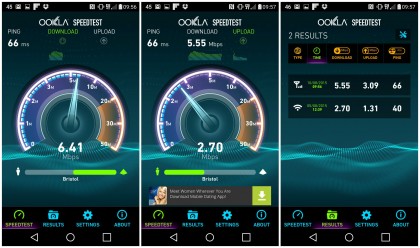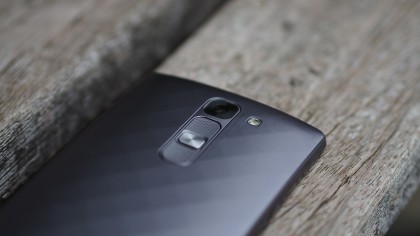Why you can trust TechRadar
Battery life
Battery life is another battleground for manufacturers. Bigger units and more optimised skins are just the beginning of what is being put on offer.
Again, LG opts to take a quiet approach. It doesn't make any grand claims or proclamations regarding the battery life of its new device, it merely states a fact: the G4c has a 2540 mAh unit. So what does this mean in general usage?
Great things! The battery life is stellar. I started using the phone at 8am, and between checking social media, reading, using maps, gaming, and streaming music, I found that it easily lasted until 6pm the following day.

Whether this was due to the processor being particularly efficient, or to small optimisations made in the background, the G4c certainly has stamina to spare. The ability to hot-swap the battery only sweetens the deal, making this an attractive option for road warriors on a budget.
LG, like many other smartphones, has also provided a power-saving mode, which if activated will kick-in when the battery reaches 15% or less. This will restrict background data usage and throttle processor performance in order to eke out a few extra hours.
Although this doesn't quite equal the crazy battery saving modes of certain flagship devices, like the Samsung Galaxy S6, its inclusion is welcome.
Essentials
With 4G connectivity, the mobile internet speeds were consistently very good. Even in areas where other devices struggle to hang on to a connection, it had no issue continuing its conversation with the web.
Sign up for breaking news, reviews, opinion, top tech deals, and more.
Like many budget devices, the LG G4c's internal memory leaves much to be desired, however. Asides from the paltry RAM allocation, this is the most obvious cost-cutting measure. With only 8GB of internal storage, of which roughly 5GB is available to the user, even the most space-conscious person will feel the squeeze.

Although a MicroSD card slot is present, and Android can switch apps to this, doing so is a finicky process, and not every app is compatible. After installing a few games and apps, most users will find themselves in a tight corner. This could seriously limit the appeal of the device.
Taking calls on the G4c was a pleasure; the speaker quality was pleasant and plenty loud, not struggling to make itself heard over the likes of a busy road. GPS performance was generally good, too, and getting a lock was achieved quickly.
LG's built-in keyboard proved to be something of a mixed affair. Of all the OEM keyboards, it is among the better options, but the lack of gesture typing functionality seriously limits its potential appeal.

The removable back-plate comes in several other colours, including white and gold, giving some extra options for those who like to accessorise their devices.
Camera
It seems that some of the most rigorous competition in the smartphone world is taking place at the budget level, especially in the camera stakes. Long out of reach, the 13MP sensor has made its debut in this space, taking the flagship technology of years past and applying it to today's low to mid-range efforts.
LG in particular has made a great play of its camera credentials in the past few months. While the G2 and G3 had competent snappers, the company went all out with the G4. Sporting a larger sensor than most other mobile devices, laser auto-focus, a dedicated white-balance sensor and an improved flash, the device was aimed as a serious tool for enthusiast photographers.

This isn't really the case with the G4c. Sporting an 8MP rear-facing effort with a single LED flash, in addition to the 5MP front-facing camera, the only similarity this device shares with its better endowed sibling is a camera interface.
And, in all, it is a very simple interface, indeed. The base version, intended for those without any intention of getting into the nitty-gritty of their photography, simply allows for the selection of a focus point before an image is taken.
There's a slightly more in-depth version, too, for those who want extra control. In this mode it is possible to switch between the front- and rear-cameras and the video capture mode. The flash can also be turned on, off or set to automatic.
A small cog allows access to more complicated settings, allowing the image ratio to be changed, voice capture to be activated, a shot timer to be activated, a rule of thirds grid to be displayed and a quick toggle to choose where images are saved. You can choose the internal memory or the MicroSD card.

When compared to some of its competitors' efforts, this is a Spartan offering. Lacking any beauty modes, filters and other crazy features that have become commonplace, those seeking a little more 'fun' from their mobile photography will have to consign themselves to downloading dedicated apps.
As for the images produced, they there something of a mixed bag. On the whole, with 8MP to spare, detail resolved is decent. Images are reasonably clear, and the white balance is generally on point, although it veers towards the cooler side.
The sensor has an unfortunate tendency to over-expose in difficult conditions. however, lacking an effective HDR-mode to combine different exposures. As such, in most images, the sky is often completely blown-out.

This is also true of the selfie camera; it's competent, but ultimately lacking. As with many other front-facing sensors, it has a tendency to produce very 'flat' images, lacking colour and depth, but should prove to be adequate for all but the most demanding of Instagram-istas.
As might be expected, video produced also follows this trend, looking quite flat and dull.
Current page: Battery life, essentials and camera
Prev Page Skins, sound quality and performance Next Page Camera samplesSean is a Scottish technology journalist who's written for the likes of T3, Trusted Reviews, TechAdvisor and Expert Reviews.
